![]()
![]()
![]()
Use LEFT and RIGHT arrow keys to navigate between flashcards;
Use UP and DOWN arrow keys to flip the card;
H to show hint;
A reads text to speech;
27 Cards in this Set
- Front
- Back
|
When was the romantic era? |
1780-1910 |
|
|
What was crucial for the social change in music? |
The decline of the old system of patronage |
|
|
Note able romantic composers |
Tchaikovsky Dvorak Brahms |
|
|
General characteristics of romantic |
More personal expression evident which came with more freedom of form and design Formal distinctions between each movement began to break down Closer links to the other arts gave rise to programmatic music e.g. symphonic poem Recurring themes developed and transformed e.g. idée fixe (Berloiz), leitmotifs (Wagner) and thematic transformation (Liszt) Greater variety in type of music e.g. shot piano pieces to multi-movement orchestral works Orchestra expanded Improvements in various instruments (brass became valved) Orchestra palette become rich and colourful, capable of massive dynamic contrasts More emotive, less mechanical thematic material Emphasis on lyrical expressive melodies Emphasis on virtuosic music Range and power of piano increased (also greater use of pedals) Contrasting textures Harmonic exploration evident e.g. adventurous modulations and dissonance Growth of nationalism (against German influence) Commercialism flourished e.g. concerts, journals and published music |
|
|
Composers of symphonic works 1830-1910 |
Schubert Mendelssohn Berlioz Schumann Liszt Brahms Dvorak Mahler Tchaikovsky Strauss Spohr Ives Scriabin |
|
|
What are we studying |
Brahms Symphony No1 Mvt 4 in C minor |
|
|
Premiere |
November 1876 in Karlsruhe, Germany |
|
|
Tagged what |
Beethoven's tenth |
|
|
Orchestration |
Solo violin, first and second violins, violas, cellos, double basses 2 flutes, 2 oboes, 2 clarinets, 2 bassoons, contrabassoon 4 horns, 2 trumpets, 3 trombones Timpani |
|
|
Key |
C minor |
|
|
Description of structure |
Sonata form but the Recapitulation is fused with a development section |
|
|
Traditional Sonata form |

|
|
|
Brahms Sonata form |
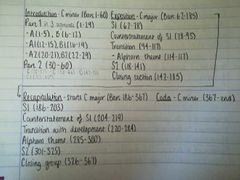
|
|
|
Similarities between Brahms and Beethoven |
Simple in style Folk/hymn-like Dactylic rhythms (minim crotchet crotchet) Similar harmonic profile Conjunct (stepwise) movement Narrow range |
|
|
Example of a dom 7th in C |
G-B-D-F natural |
|
|
Dom 7ths |
-32 -36 -77 -117 (D7 chord prepares us for the new key of G major in S2 of the Exposition) -381-390 (prepare us for tonic key of C) -389-390 (accented Dom 7th chords except trombone) |
|
|
Dim 7th on C |
C-Eb-Gb-Bbb/A |
|
|
Dim 7ths |
-15 (neapolitan gives way to dim 7th harmony) -23 (following rapid ascending violin scales, orchestral texture erupts in a series of dim 7th chords) -285 (alphorn theme against dim 7th harmony) |
|
|
What is a neapolitan chord and an example with C |
A major triad on the lowered supertonic (2nd) Db-F-Ab |
|
|
Neapolitan chords |
-8 (dom major, Gb major chord could be neapolitan of following F minor) -12 (sudden stop with a neapolitan chord in first inversion in C minor in strings) -15 (gives way to dim 7th) -249 (neapolitan flavours alternate with C. Could just be enharmonics to enable change of keys) -373 |
|
|
Cadences |
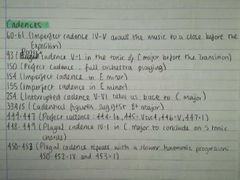
|
|
|
What is figure 'x' |
Four note descending tetrachord motif |
|
|
Figure 'x' |
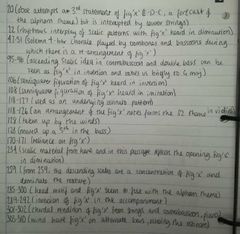
1-2 (movement opens with violas and lower strings playing the figure, marked piano) 6-7 (ascending reversal of fig 'x' in double bass) |
|
|
Head motif |
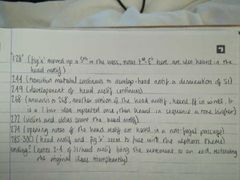
1-3 (violins and horns enter with head motif, anticipating S1) 12-14 (string statement, condensed from 4 bars to 3) 61⁴-67³ (S1 begins with head motif played by violins in low register, accompanied by violas, bass and horns - homophonic) 95-97 (upper strings and violas in diminution) 98-101 (95-97 but ascending) |
|
|
S1 theme |
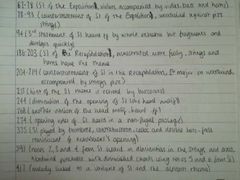
Ending (notes 2-4 of S1 bring the movement to an end, reiterating the ideas with which it began, but triumphantly) |
|
|
Alphorn theme |
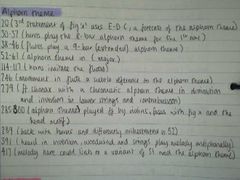
|
|
|
S2 theme |

|

